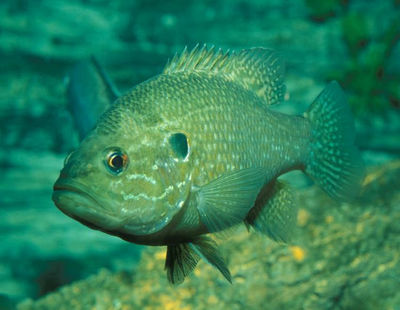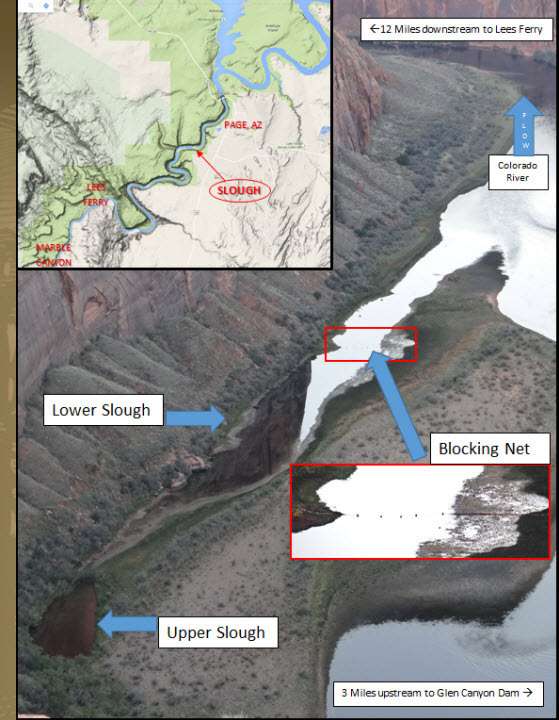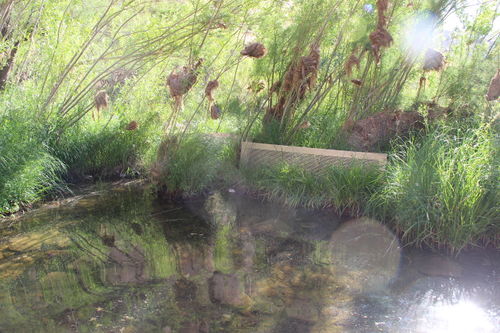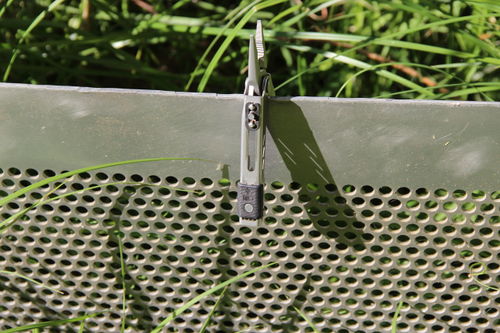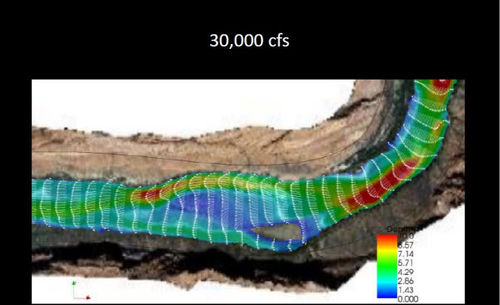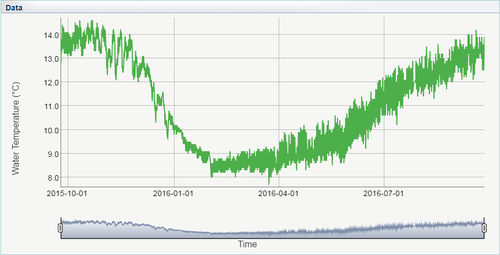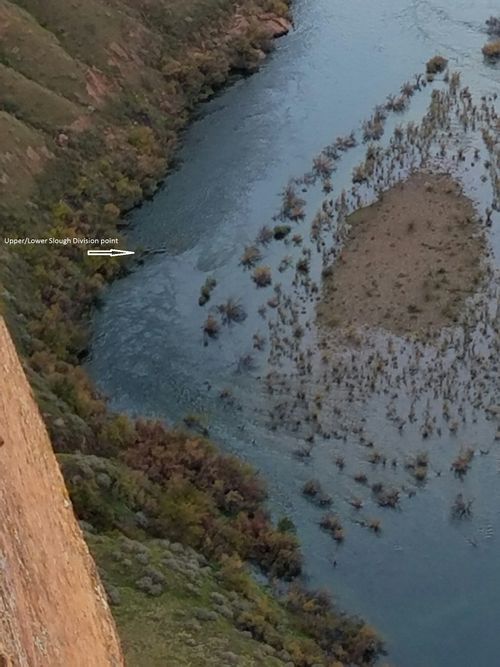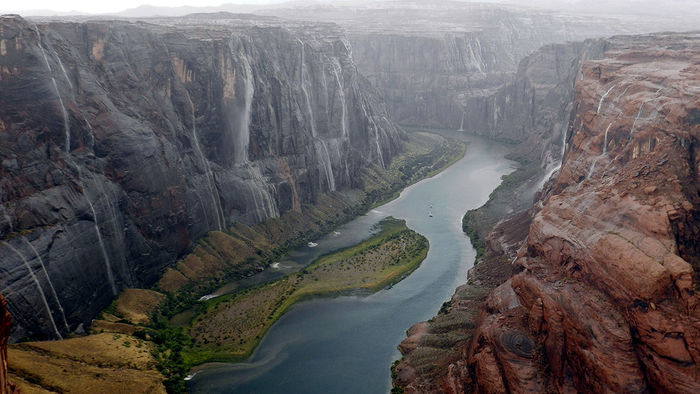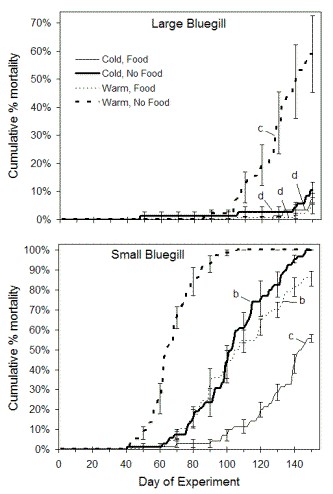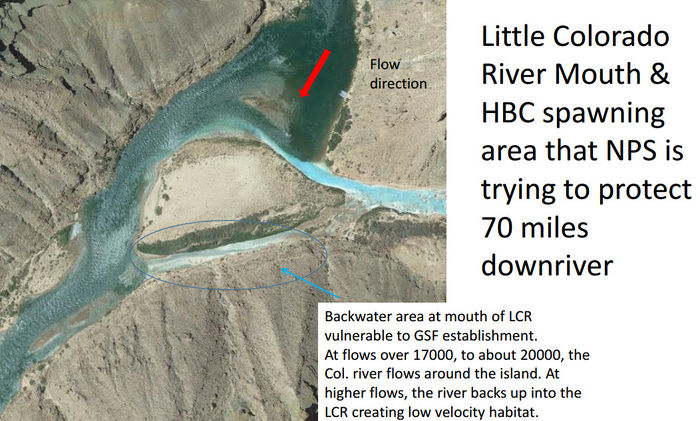Difference between revisions of "Green Sunfish Page"
Cellsworth (Talk | contribs) |
Cellsworth (Talk | contribs) |
||
| Line 18: | Line 18: | ||
[[File:GreenSunfish2.jpg|center|400px]] <br> | [[File:GreenSunfish2.jpg|center|400px]] <br> | ||
| − | + | [[file:Slough.jpg|center|600px]] <br> | |
| − | [[ | + | |
| − | + | ||
| − | + | ||
<!-- | <!-- | ||
| Line 83: | Line 80: | ||
(10/24/16) The ammonia treatment to eradicate green sunfish from the isolated pond at river mile -12 in Glen Canyon began at approximately noon on Thursday October 20, 2016 when crews applied 20 gallons of ammonia to the pond. Dead and dying green sunfish were observed within about 90 minutes. To help confirm the effectiveness of the treatment, 14 cages with from 3 to 20 sentinel green sunfish each were placed in locations throughout the pond. Crews checked the pond at 1430 hours and observed dead green sunfish on the bottom of the pond and in the sentinel cages although not all the sentinel fish were dead. Crews returned to the pond the morning of Friday October 21, 2016 and found that all the sentinel green sunfish were dead. They also counted 939 dead juvenile green sunfish as well as 10 dead carp, 7 adults and 3 juveniles. The crews electrofished the pond and collected 3 live juvenile green sunfish and 1 live juvenile carp from one small area near the upstream end of the pond where a small amount of water was flowing into the pond. These fish appeared to have been affected by the ammonia, but hadn’t yet succumbed unlike other dead green sunfish observed in this same small area. The captured green sunfish were sacrificed and crews poured in one gallon of ammonia to spot treat this area to ensure any other remaining fish would be killed. No other live fish were observed. Ammonia levels in the pond will remain at levels lethal to green sunfish for 7 to 14 days, thus we are confident that the treatment will eradicate green sunfish from this site. Another electrofishing survey is scheduled for Tuesday October 25, 2016 to confirm green sunfish have been eliminated from the pond. Surveys for green sunfish at two other locations in Glen Canyon that might be suitable for rearing of young fish were also conducted this week. Two baited minnow traps were set at “frog marsh” at rive mile -8 and four baited minnow traps at the hidden slough at rive mile -6.5 on Wednesday October 19, 2016. The traps were retrieved after 24 hours and no fish were captured. <br> --Scott VanderKooi, GCMRC | (10/24/16) The ammonia treatment to eradicate green sunfish from the isolated pond at river mile -12 in Glen Canyon began at approximately noon on Thursday October 20, 2016 when crews applied 20 gallons of ammonia to the pond. Dead and dying green sunfish were observed within about 90 minutes. To help confirm the effectiveness of the treatment, 14 cages with from 3 to 20 sentinel green sunfish each were placed in locations throughout the pond. Crews checked the pond at 1430 hours and observed dead green sunfish on the bottom of the pond and in the sentinel cages although not all the sentinel fish were dead. Crews returned to the pond the morning of Friday October 21, 2016 and found that all the sentinel green sunfish were dead. They also counted 939 dead juvenile green sunfish as well as 10 dead carp, 7 adults and 3 juveniles. The crews electrofished the pond and collected 3 live juvenile green sunfish and 1 live juvenile carp from one small area near the upstream end of the pond where a small amount of water was flowing into the pond. These fish appeared to have been affected by the ammonia, but hadn’t yet succumbed unlike other dead green sunfish observed in this same small area. The captured green sunfish were sacrificed and crews poured in one gallon of ammonia to spot treat this area to ensure any other remaining fish would be killed. No other live fish were observed. Ammonia levels in the pond will remain at levels lethal to green sunfish for 7 to 14 days, thus we are confident that the treatment will eradicate green sunfish from this site. Another electrofishing survey is scheduled for Tuesday October 25, 2016 to confirm green sunfish have been eliminated from the pond. Surveys for green sunfish at two other locations in Glen Canyon that might be suitable for rearing of young fish were also conducted this week. Two baited minnow traps were set at “frog marsh” at rive mile -8 and four baited minnow traps at the hidden slough at rive mile -6.5 on Wednesday October 19, 2016. The traps were retrieved after 24 hours and no fish were captured. <br> --Scott VanderKooi, GCMRC | ||
| + | '''2016 Summary''' | ||
*10 removal trips from August - October captured and removed 4,600 green sunfish from the upper slough. | *10 removal trips from August - October captured and removed 4,600 green sunfish from the upper slough. | ||
*Based on depletion sampling, the final estimate before the ammonia treatment was that there were approximately 261 (95% CI: 192-343) green sunfish remaining in the upper slough. [https://www.usbr.gov/uc/rm/amp/twg/mtgs/16oct18/Attach_06a.pdf] | *Based on depletion sampling, the final estimate before the ammonia treatment was that there were approximately 261 (95% CI: 192-343) green sunfish remaining in the upper slough. [https://www.usbr.gov/uc/rm/amp/twg/mtgs/16oct18/Attach_06a.pdf] | ||
| Line 93: | Line 91: | ||
In July 2015 AGFD biologists discovered an unusually large, reproducing population of invasive green sunfish in the slough. Green sunfish are prolific, with a single female producing up to 10,000 eggs. They are also voracious predators of native fish and their eggs. Biologists with the AGFD, NPS, USGS, FWS, and BOR determined that green sunfish pose a threat to native fish including the [http://gcdamp.com/index.php?title=Humpback_Chub_Page '''humpback chub (''Gila cypha'')''']. A rapid response action is necessary to eradicate the population of sunfish before it spreads downstream into critical habitat for the endangered humpback chub. [http://www.nps.gov/glca/learn/news/Rapid-Response-Treatment-to-Remove-Invasive-Green-Sunfish-from-a-Backwater-Slough.htm (2015 NPS Press Release)] This resulted in the cancellation of the [http://gcdamp.com/index.php?title=GCDAMP-_HFE_2015 fall 2015 HFE]. | In July 2015 AGFD biologists discovered an unusually large, reproducing population of invasive green sunfish in the slough. Green sunfish are prolific, with a single female producing up to 10,000 eggs. They are also voracious predators of native fish and their eggs. Biologists with the AGFD, NPS, USGS, FWS, and BOR determined that green sunfish pose a threat to native fish including the [http://gcdamp.com/index.php?title=Humpback_Chub_Page '''humpback chub (''Gila cypha'')''']. A rapid response action is necessary to eradicate the population of sunfish before it spreads downstream into critical habitat for the endangered humpback chub. [http://www.nps.gov/glca/learn/news/Rapid-Response-Treatment-to-Remove-Invasive-Green-Sunfish-from-a-Backwater-Slough.htm (2015 NPS Press Release)] This resulted in the cancellation of the [http://gcdamp.com/index.php?title=GCDAMP-_HFE_2015 fall 2015 HFE]. | ||
| − | '''Results from 2015 removals''' <br> | + | '''Results from 2015 removals:''' <br> |
| − | + | *July 6: 43 (all lower slough) <br> | |
| − | + | *August 12-14: 954 <br> | |
| − | + | *August 27-28: 2,574 <br> | |
| − | + | *October 27-29: 775 (39 lower, 736 upper) <br> | |
| − | + | *November 15: 1,967 (rotenone treatment; 180 lower, 1,787 upper) <br> | |
| − | + | '''Presentations and Photos:''' | |
*[http://www.lcrmscp.gov/crab/presentations/2016/crab16_34.pdf Green Sunfish Removal in a Colorado River Backwater Below Glen Canyon Dam ] | *[http://www.lcrmscp.gov/crab/presentations/2016/crab16_34.pdf Green Sunfish Removal in a Colorado River Backwater Below Glen Canyon Dam ] | ||
*[http://www.usbr.gov/uc/rm/amp/twg/mtgs/16jan26/documents/Attach_05b.pdf Colorado River Slough Green Sunfish Removal] | *[http://www.usbr.gov/uc/rm/amp/twg/mtgs/16jan26/documents/Attach_05b.pdf Colorado River Slough Green Sunfish Removal] | ||
*[http://www.usbr.gov/uc/rm/amp/twg/mtgs/16jan26/documents/Attach_05a.pdf Green Sunfish Rapid Response Treatment, Nov 2-6 and Nov 12-13, 2015 Brief Treatment Summary] | *[http://www.usbr.gov/uc/rm/amp/twg/mtgs/16jan26/documents/Attach_05a.pdf Green Sunfish Rapid Response Treatment, Nov 2-6 and Nov 12-13, 2015 Brief Treatment Summary] | ||
*[https://goo.gl/photos/e9fYmrEWVeEBujiA6 Photos of the 2015 green sunfish treatment] | *[https://goo.gl/photos/e9fYmrEWVeEBujiA6 Photos of the 2015 green sunfish treatment] | ||
| − | |||
| − | |||
[[File:SloughConnection.jpg|thumb|center|500px|Two-dimensional streamflow model of predicted water surface extent and depths in Lees Ferry, RM -12 slough showing full connection at modeled flows of 30,000 cfs]] <br> | [[File:SloughConnection.jpg|thumb|center|500px|Two-dimensional streamflow model of predicted water surface extent and depths in Lees Ferry, RM -12 slough showing full connection at modeled flows of 30,000 cfs]] <br> | ||
| Line 112: | Line 108: | ||
[[file:LeesFerryDischarge2015 2016.jpg|center|500px]] | [[file:LeesFerryDischarge2015 2016.jpg|center|500px]] | ||
[[file:LeesFerryTemperature2015 2016.jpg|thumb|center|500px|Colorado River discharge and temperature measured at Lees Ferry from fall 2015 to fall 2016.]] <br> | [[file:LeesFerryTemperature2015 2016.jpg|thumb|center|500px|Colorado River discharge and temperature measured at Lees Ferry from fall 2015 to fall 2016.]] <br> | ||
| + | |||
| + | [[File:GSF sloughs HFE 11102016 KH.jpg|thumb|center|500px|The Slough during the 2016 HFE at 38,000 cfs]] <br> | ||
|} | |} | ||
Revision as of 15:50, 31 May 2017
|
Green Sunfish (Lepomis cyanellus)Description: Native to the Great Lakes, Hudson Bay and the Mississippi River basin. Introduced into Arizona in 1926. Large mouth with blue-green striations on the cheeks. Opercle flap is black with reddish or orange border. Bodies olive-green in color, dark vertical bars are faintly seen on sides. Pectoral fin short and rounded. Caudal fin and lower fin margins are white or yellowish with dusky spots at rear of dorsal and anal fins. Length: 3 to 12 inches. Weight: 3 ounces to 1 pound 8 ounces. May live to nine years. Location and Habitat: Found in most seasonally warm water lakes and streams in Arizona. Prefer lakes with rocky substrate and piles of rubble, but can be found in slow moving rivers and riverine backwaters. Green sunfish have been found at a wide range of stream gradients, varying from 0.2 to 5.7 m/km; however, they are most abundant at lower (<2 m/km) gradients. They prefer small to medium-sized (<30 m width) streams.[1] Being native to the Great Lakes and Mississippi River Basin, green sunfish are well suited to tolerate long periods of cold water. Temperature: Being native to the Great Lakes and Mississippi River Basin, green sunfish are well suited to tolerate long periods of cold water. The summertime temperature preference for adult green sunfish is 28.2° C and, when possible, they avoid temperatures above 31° C or below 26° C. Growth and food conversion efficiency increase as temperature increases from 13.2 to 28° C. Optimal temperatures for fry range from 18 to 26° C. The range of tolerance for bluegill fry is 10 to 36° C, and it is assumed that green sunfish fry tolerances are similar. Temperature requirements for juveniles are assumed to be the same as those for adults.[2] 2015-2016 temperatures in the mainstem ranged from 8.0-15.5 C between Lees Ferry and the Little Colorado River. 2015-2016 temperatures in the Little Colorado River ranged from 10.0-28.0 C and are within the temperature tolerances of green sunfish spawning and growth. Turbidity and Dissolved Oxygen: Green sunfish tolerate greater turbidity and lower dissolved oxygen than other sunfish.[3] Moderate (25-100 JTU) turbidities correlated with high species abundance are optimum.[4] Ventilation rates were not affected by bentonite clay suspensions below 2,125 FTU at 5 C, 1,012 FTU at 15 C, and 898 FTU at 25 C. At turbidity levels exceeding 1,012 FTU at 15 C and 898 FTU at 25 C ventilation rates increased 50-70%. Oxygen consumption rates were not affected by turbid suspensions of up to 3,500 FTU at any of the four temperatures.[5] Salinity: Green sunfish have preferred salinity tolerances <0.36% and will not tolerate salinity >0.56%.[6] The Little Colorado River has a naturally high salinity at baseflow ranging from 0.22% - 0.36%.[7] Reproduction: Optimal temperature for spawning and subsequent development ranges from 20 to 27° C. Spawning will not occur below 19° C or above 31° C.[8] Males build nests in shallow pools over gravel, sand or bedrock. The nests are usually within a couple feet of each other. The male guards the nest and hatched fry. Males constantly show defensive displays and fight with other males who come too close. It is thought that green sunfish may produce the same number of eggs as bluegill, which is roughly 50,000 eggs per female. It takes normally 1 to 2 days for the eggs to hatch and another 5 to 7 days of protection from the male until the fry become independent. Green sunfish can spawn up to every 8 to 10 days during the spawning season.[9] Food: Green sunfish will eat anything they can catch and swallow. Aquatic and terrestrial insects and invertebrates are the most common food items. Small crayfish, humpback chub, and frogs are all in danger when green sunfish are present. Young life stages of chub do not persist in streams occupied by Green Sunfish. No recruitment of young-of-year Gila Chub (Gila intermedia) occurred in the presence of sunfish in Sabino Creek, Arizona (Dudley and Matter, 2000). Risk: Green sunfish may temporarily be displaced into colder more unfavorable environments where survival might be lower, but the fish that do survive will seek out warm backwaters and tributaries after moving downstream. An upstream source that continues to allow new individuals to disperse downstream and colonize tributaries, when they are not in flood stage, greatly increases the likelihood of sunfish establishment in tributaries of the CRe. If no action is taken, there is a high risk of sunfish spreading downstream and becoming established in and near other tributaries, primarily the Little Colorado River, where negative impacts to the endangered humpback chub will occur. (Green Sunfish Risk Assessment) |
| Online training |
Fish Species of the Colorado River in Lower Glen Canyon and Grand Canyon |
Fish photos, information, and maps |
|---|
|
|
